In May this year we went to Nelson to the launch of the latest gen Honda Jazz. The car impressed with its driveability, looks and equipment levels, but that was only a day’s drive, split between the three models.
At last, we get to do a full review of the Jazz and with an extended drive time of a couple of weeks, and we managed to get over 2,000km on the car, including a trip to Taupo and back. This is the first test for us for the 2021 Honda Jazz, and we’re starting with the top-spec e:HEV Luxe, the hybrid version. The other model’s reviews will come shortly.
Want to know what the 2021 Honda Jazz e:HEV Luxe is really like after 2,400kms behind the wheel? Read on.

What’s In The 2021 Honda Jazz Range?
You get to choose from three models, the base model (Life), a crossover version (Crosstar) and then the top-spec e:HEV Luxe.
Your Life starts at $28,000 and is fitted with 16” alloy wheels, front and rear parking sensors, cloth seating, cruise control, an electric park brake with auto-hold, hill start assist, climate aircon, power folding mirrors, keyless entry and start, Honda’s Magic Seats, tilt/telescoping steering wheel, a 9” centre touchscreen, wireless Apple CarPlay, Android Auto capability, a 3-angle reversing camera, LED headlights, LED DRLs, and privacy glass.
The Crosstar is $30,000, with both the Life and Crosstar running a 1.5-litre, 4-cylinder petrol engine, giving you 89kW of power and 145Nm of torque. Both have a CVT transmission.
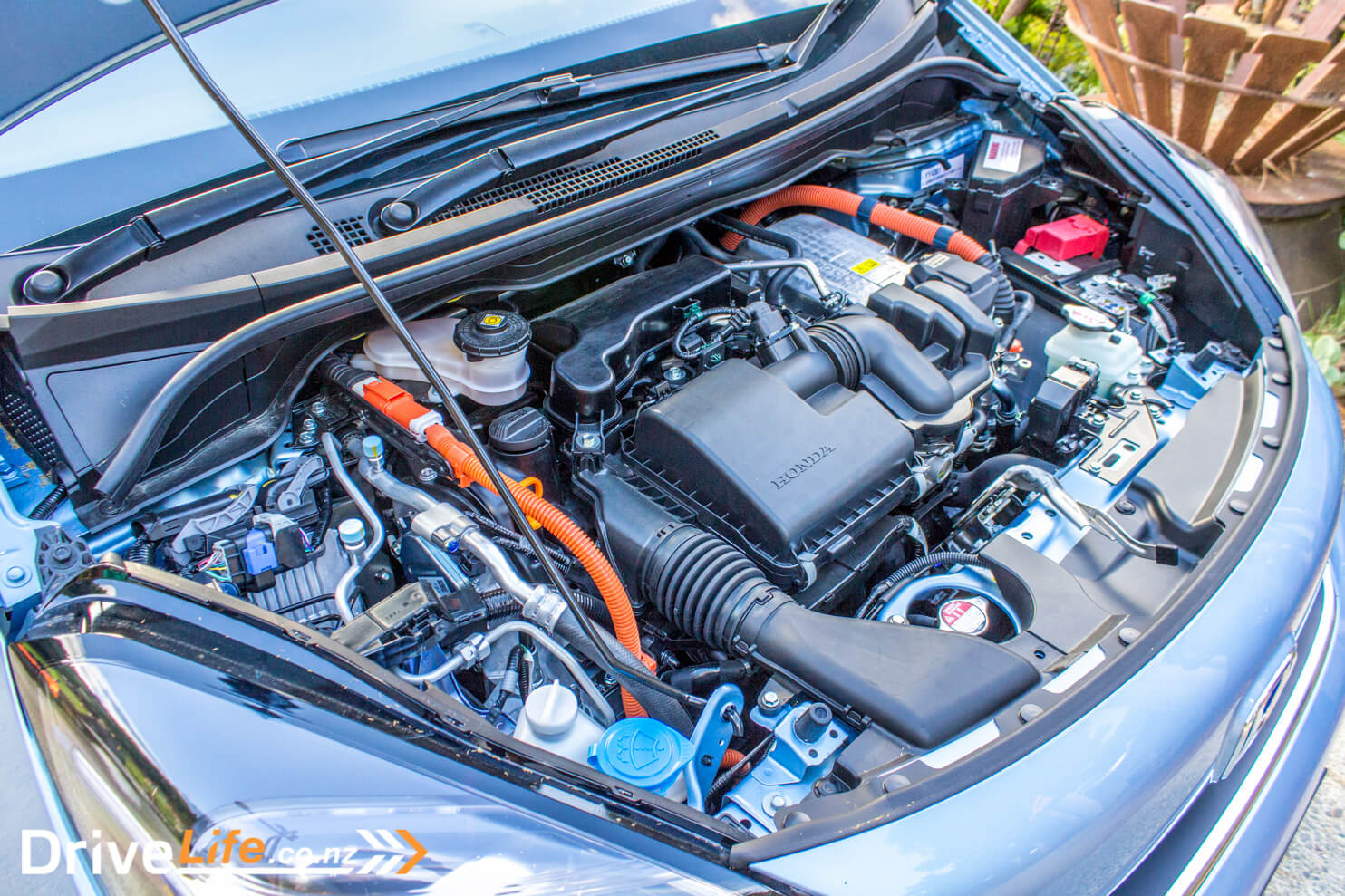
In addition to the list of standard features on the Life, the Crosstar adds waterproof fabric upholstery, soft touch fabrics on the dash, door trims and centre console knee protectors, a leather steering wheel, leather gear knob, roof rails, automatic headlights, Welcome Interior Lighting, LED fog lights, Crosstar tuned suspension and steering, increased ground clearance and ride height, an alarm, a double horn, and lastly plated finish interior door handles, climate control and air vent controls.
The e:HEV Luxe has more goodies like heated front seats, leather seating, Honda’s Sensing Safety Suite which inlcudes adaptive cruise control, collision mitigation braking system, forward collision warning, lane departure warning, lane keep assist, road departure mitigation, and automatic high beams.
There are also Luxe exclusive platinum exterior trims, and an illuminated phone tray. The e:HEV Luxe (which I’m going to call Luxe from now on, as it’s so many letters), still has a 1.5-litre engine, but it’s detuned a little to 72kW of power and 131Nm of torque, but has a hybrid system with an electric motor that manages 80kW of power and 253Nm of torque. You don’t add the power and torque figures together for the e:HEV Luxe, as that’s not the way this hybrid system works. It’s not a plug-in hybrid (PHEV), so the battery is charged while you are driving, either by using regenerative braking when slowing or going down a hill, or by the petrol engine.
You may have noticed then that there’s no hybrid crossover version yet. This means that Toyota will have one over Honda for the moment, with their excellent Yaris Cross Hybrid until such a time as Honda brings that model to New Zealand.
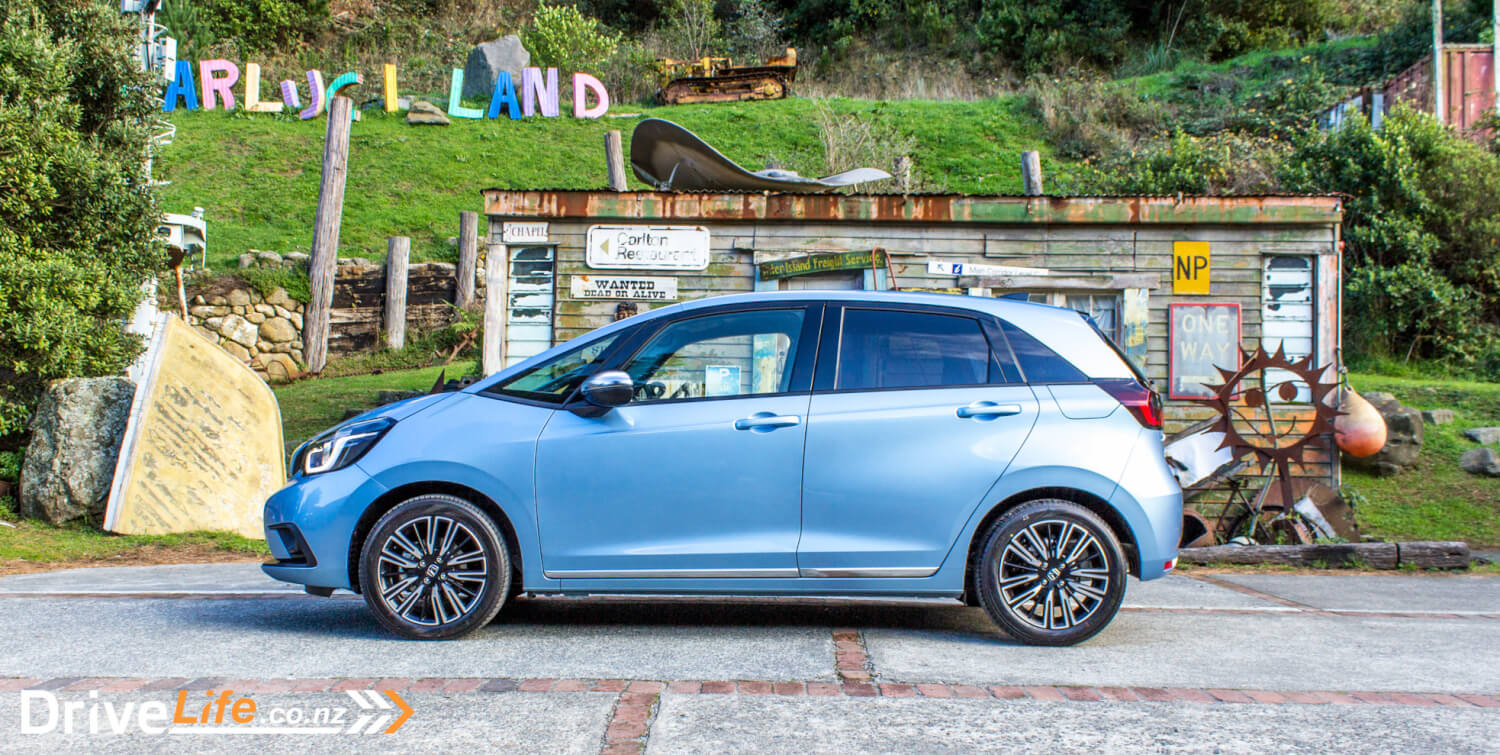
Honda NZ has gone to great lengths to make sure that you get your Jazz in whatever colour you really want, so there’s a reasonable selection. The Life is available in Luna Silver, Midnight Blue Metallic, Meteoroid Grey Metallic, Crystal Black Metallic, Premium Opal Pearl, Wind Blue metallic (our test car), Premium Crystal Red Metallic, or Platinum White Pearl.
The Crosstar adds Surf Blue, or Surf Blue in two-tone with a black roof, but loses the option of Wind Blue Metallic. If you choose the e:HEV Luxe, there’s seven choices; Wind Blue Metallic is back but Platinum White Pearl has gone.
You can read more about the Jazz on Honda New Zealand’s website.
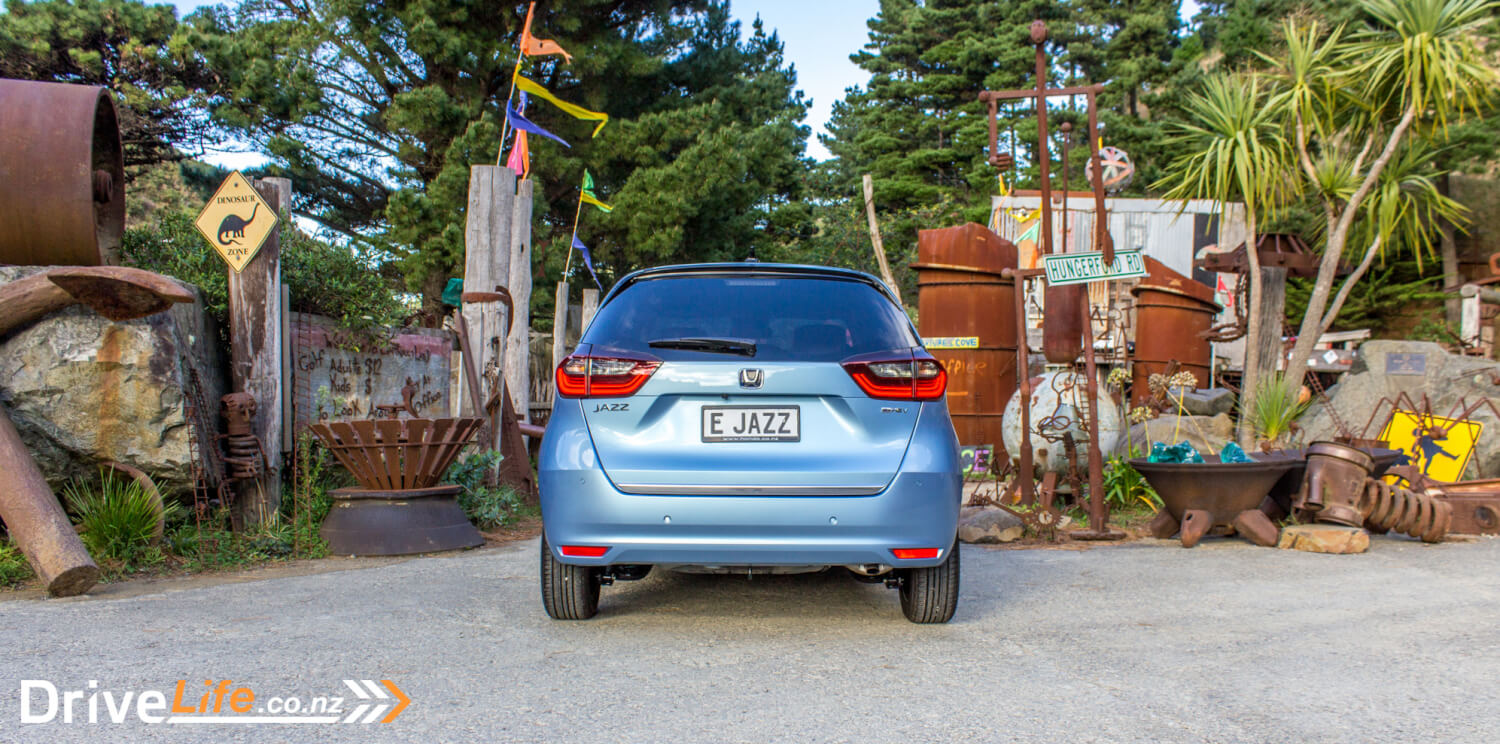
First Impressions Of The 2021 Honda Jazz e:HEV Luxe
Honda have pulled off managing to allow the Jazz to retain a look that is familiar, and yet freshen the whole car to the point where it is its own design. We see so many small or micro cars that look similar, and yet the Jazz stands alone, especially with that smiley face at the front. There’s no mistaking it for something else.

Does it look great? For me, that depends on the colour. In the Wind Blue Metallic our test car was finished in, it looks good, but I’ve seen the Premium Crystal Red Metallic model and that’s the one to get, or even Midnight Blue Metallic.
Your first impression though is that front windscreen; it’s huge, and dominates the front of the car. The rear of the car is still nice in a small car way, and can look more European than Japanese from certain angles.

What’s The Interior Like On A 2021 Honda Jazz e:HEV Luxe?
The Jazz Luxe has black leather seats, but the beige headlining and reasonably sized side windows means that the car never feels small inside, even though it is a micro car.
There’s a danger of small cars feeling claustrophobic, but not for the Jazz. Sitting in the driver’s seat, there’s that huge front windscreen that offers tremendous visibility, aided by the slim A pillars. The whole top of the dash is completely flat, and looks big enough to sit a family of four for dinner. It feels strange when so many manufacturers are trying to make the top of the dash anything but flat, but it works for making the car feel bigger. The only drawback here is reflections on sunny days, which can be a little weary.

There’s a couple of touches that also lift the interior, like the white finish used on the centre of the steering wheel and around the shift lever.
Front seat passengers have access to a single 12-volt socket for your dashcam, along with 2 standard USB ports. In Jazz tradition, there’s two glove-boxes – upper and lower. While the upper one is not huge, it’s a usable size. At the ends of the dash are cup holders for your McDs coffee, or your drink bottle. It’s a handy place to stick them for easy access.
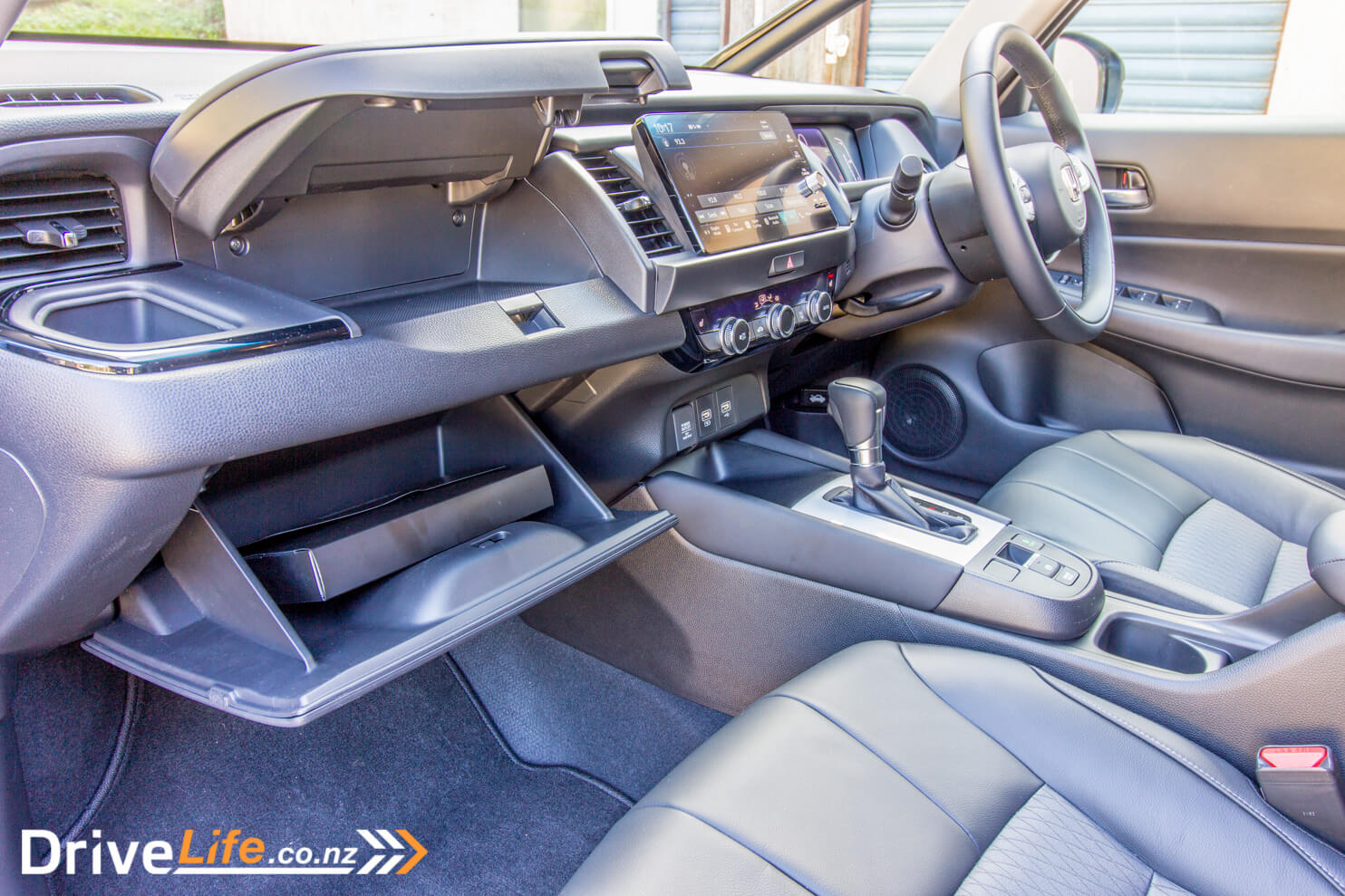
There’s also drink bottle holders in each front door, and two more cup holders at the rear of the centre console, before the cubby.
The centre console cubby itself is not large, but again, it’s usable. For the size of the Jazz, there’s plenty of storage spots, including an illuminated cellphone shelf in front of the gear lever.
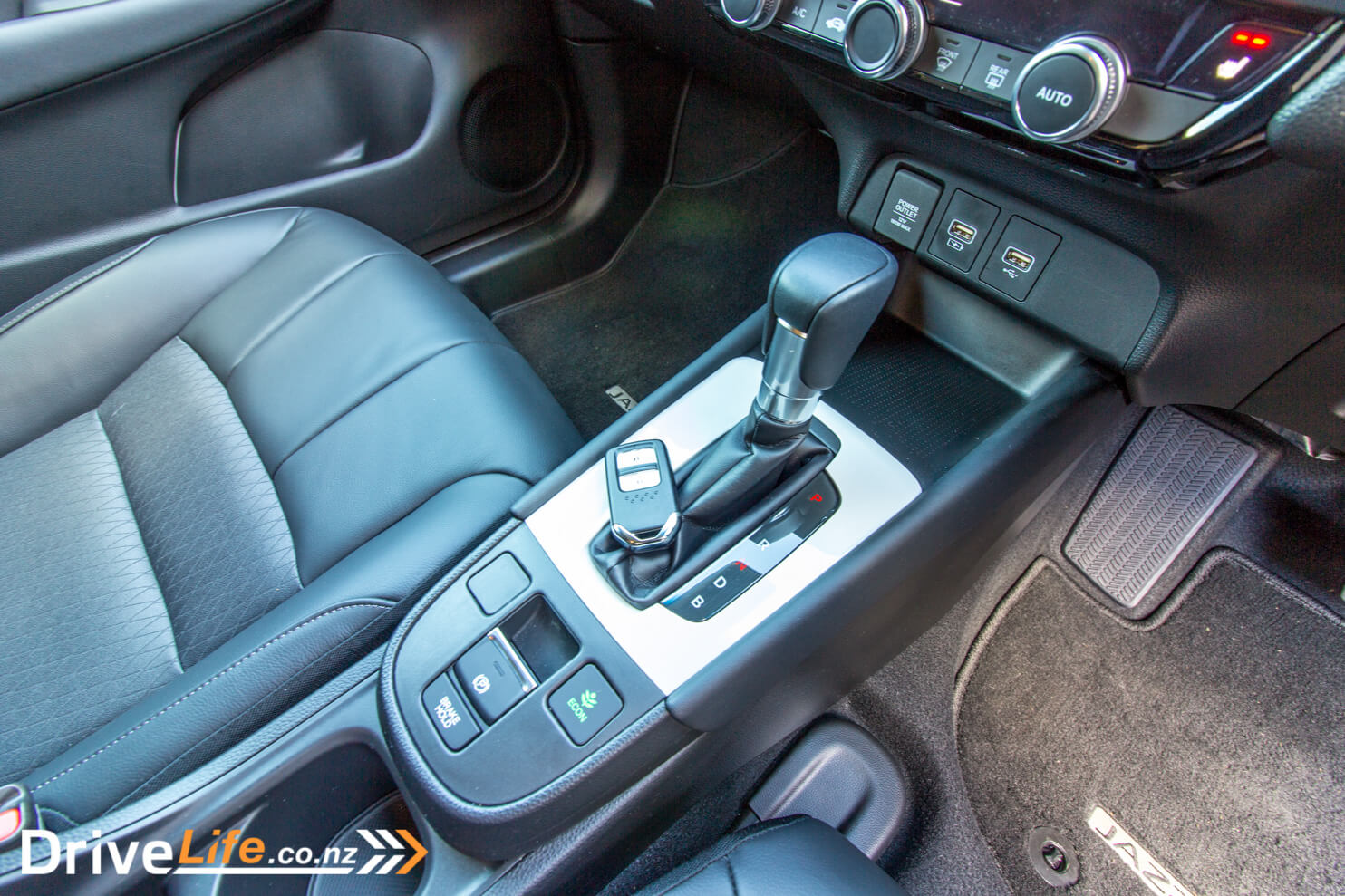
I was again happy to see that Honda are continuing with a physical volume knob and have dumped the slider idea. A knob wins hands-down, every time. Honda has mentioned more than once that there are padded knee bolsters on the sides of the centre console. This is a nice idea, but honestly, there’s not a lot of padding there for comfort. Still, it’s better than hard plastic for your knee to rest on.
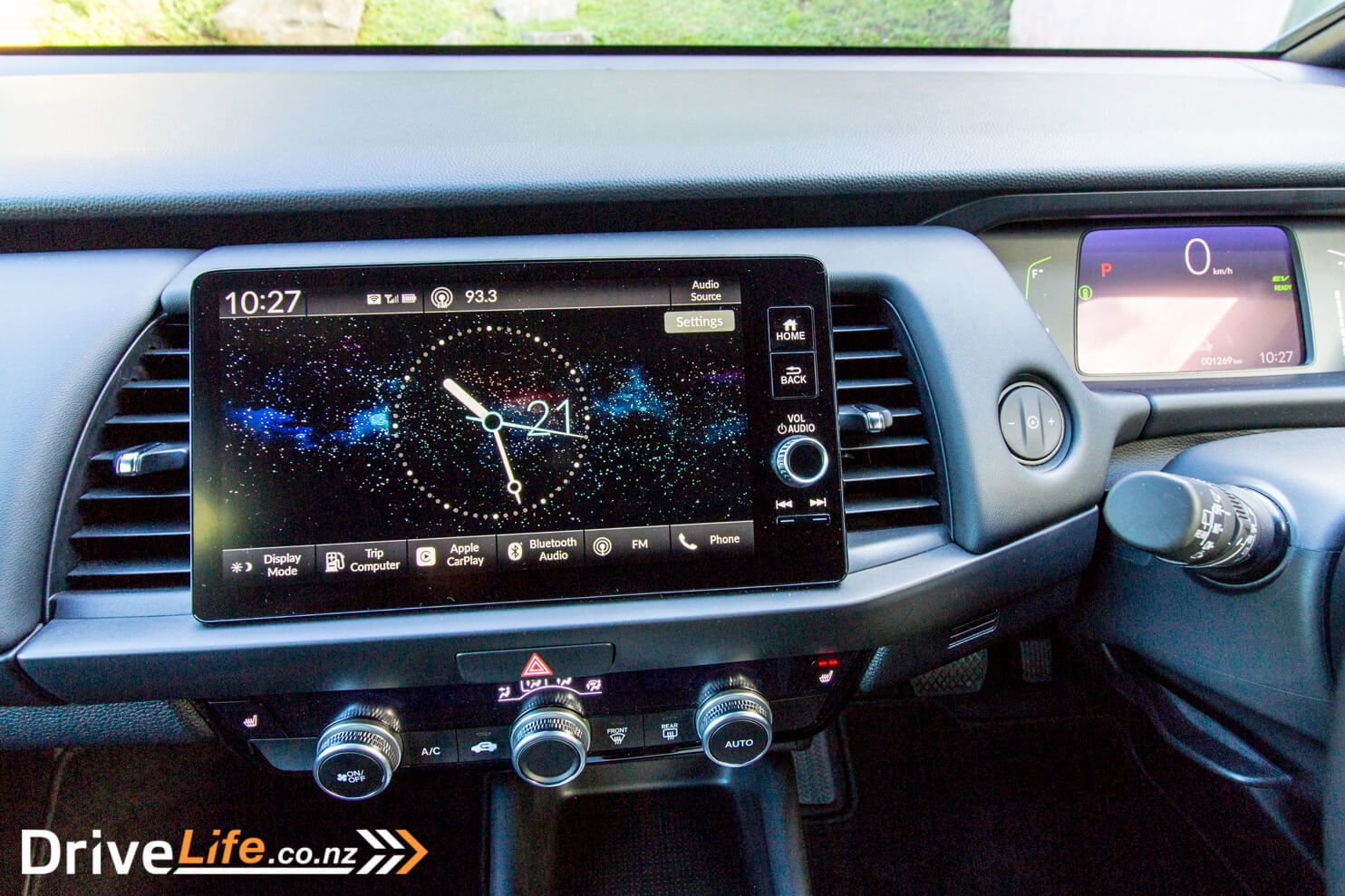
The leather steering wheel feels chunky and is great to hold. Controls are near-on perfect, with audio/phone/info display buttons on the left side, and adaptive cruise and lane keep assist on the right.
The central display is a huge improvement on any other Honda currently on sale; it’s clear, crisp, and reasonably quick. A nice touch is some shortcuts at the bottom of the screen to give you instant access to your most-used items. I’m hoping this infotainment system will flow down to other Honda models, as this is their weak point at the moment.
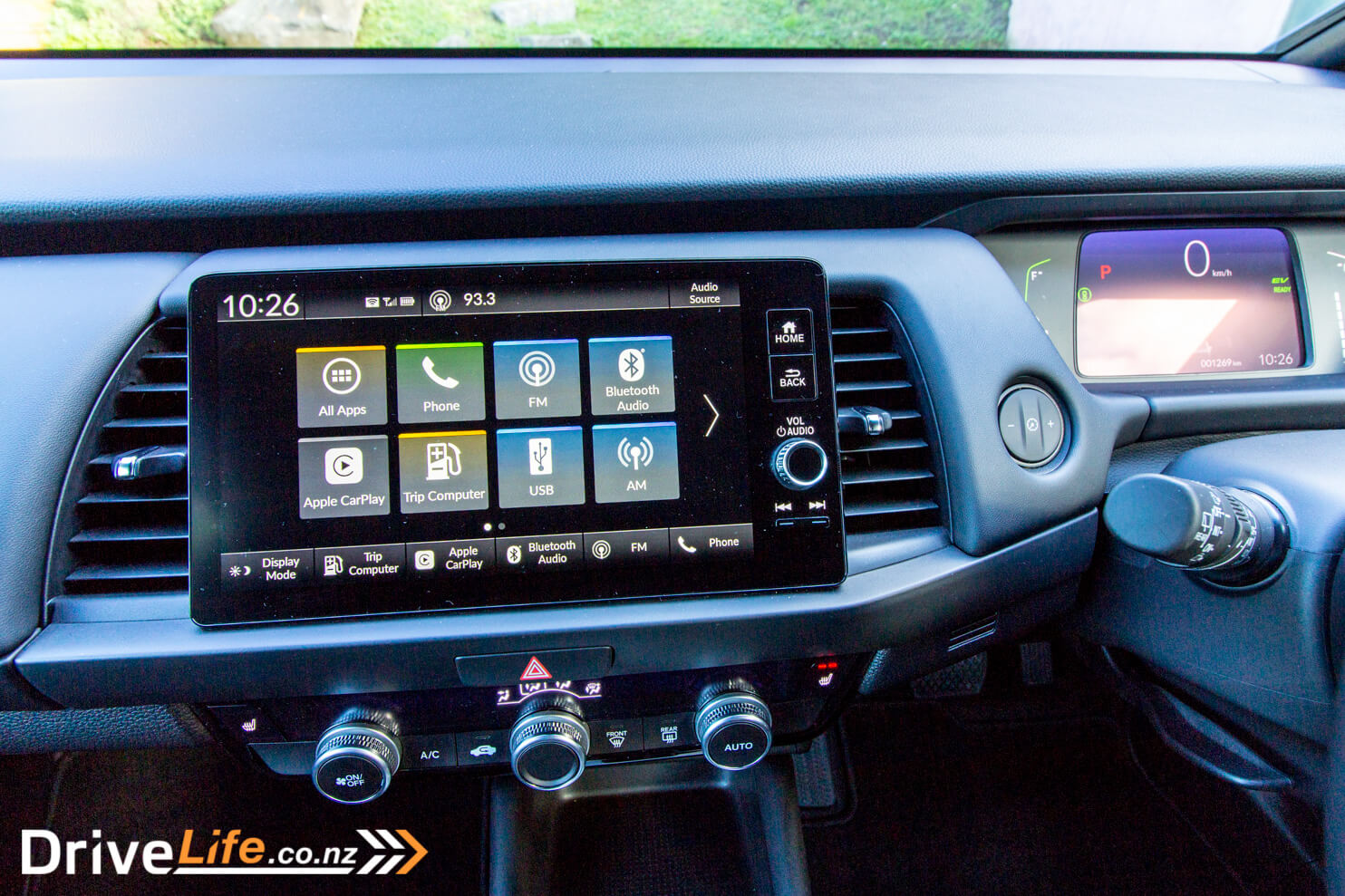
Stepping into the back seat, there they are: Magic Seats. Those who have used these as intended would find it difficult to go back to any car without them, namely any other car. They lift easily, and pushing on the metal bar locks them in place. You then have full-height floor to ceiling to carry those trees home from the garden centre. They are awesome, and here’s hoping Honda never takes them away.
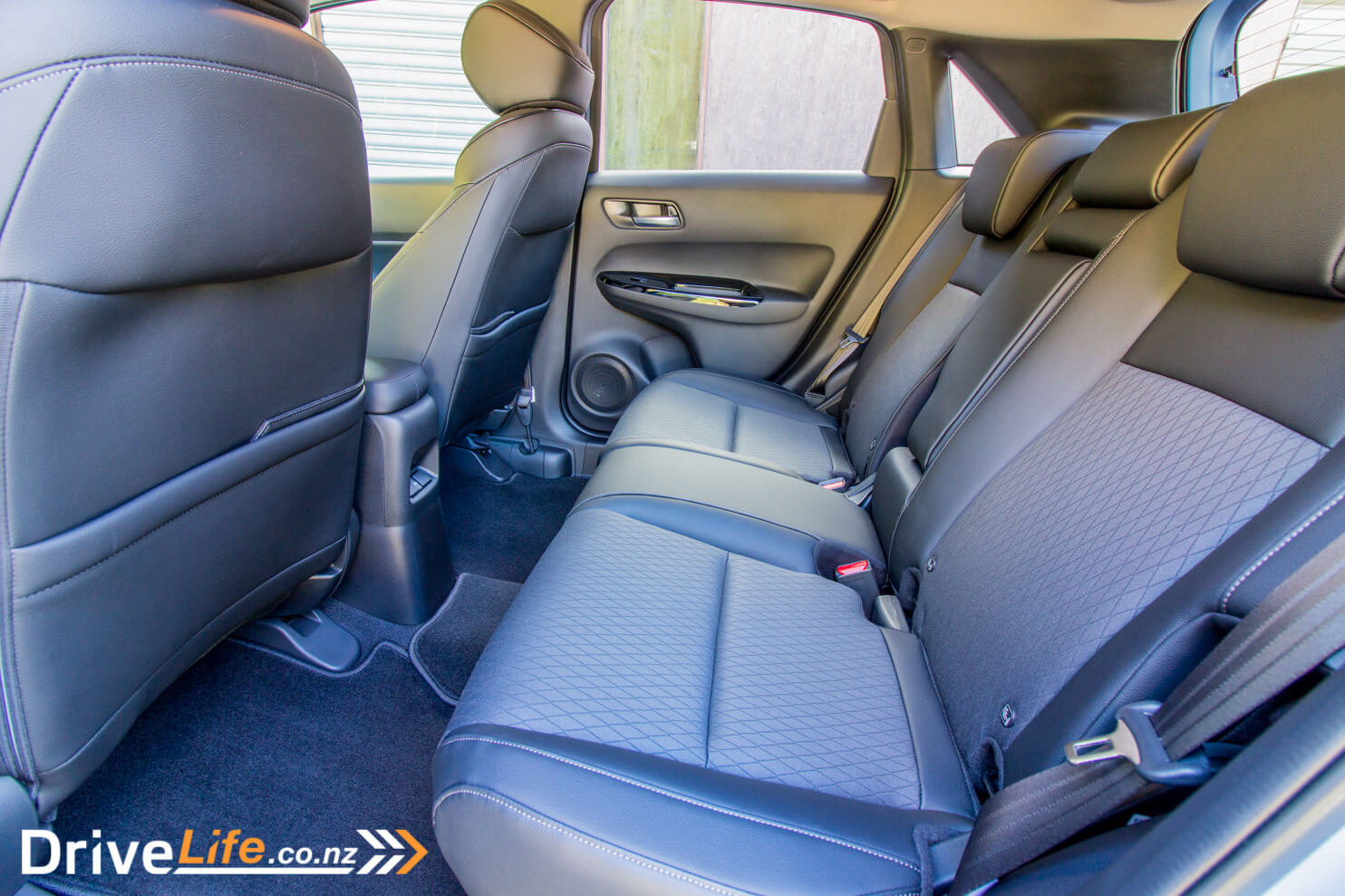
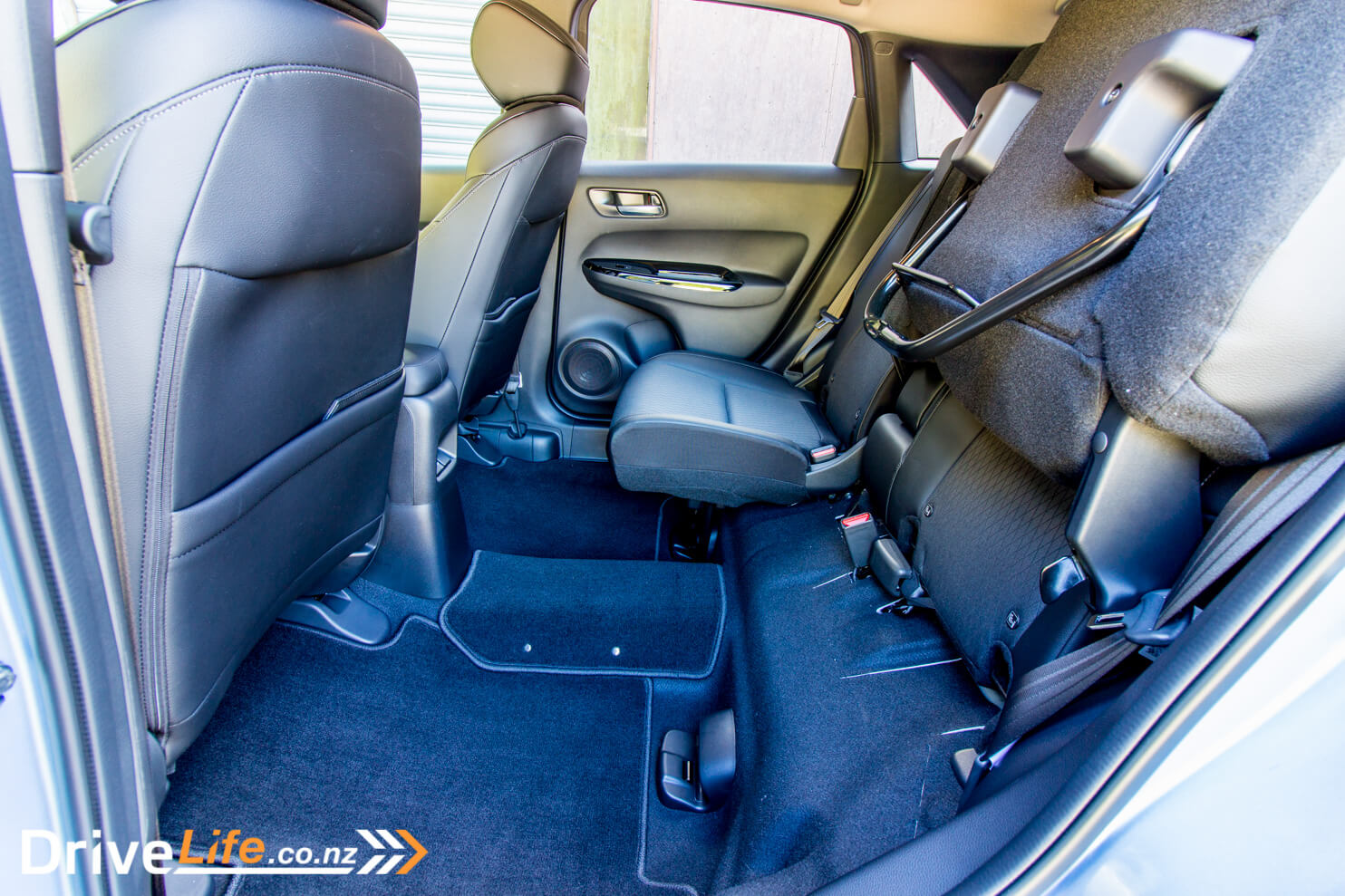

Rear leg room is awesome too – this will blow the minds of some. Honestly, I haven’t checked the measurements but it looks around the same as a Skoda Superb, and that’s saying something. There’s no lack of rear legroom in this car. Rear seat passengers also have access to two USB ports. For some reason, we’re seeing less USB ports now for back seat passengers in a small car, so this was good to see. Honda mentions that the back of the front seats have cellphone holders for rear seat passengers, and they sure do. I hate to say but, but they only allow the cellphone to sit upright. This is fine for a storage place for your cellphone, but ideally if they had a different design the phone could be held in place in landscape mode, to allow watching of movies etc. A small niggle, though at least the car has these.
The boot on the Jazz – even the hybrid model – is very good in size, at 304 litres with the seats up. And again, even on the hybrid model, there is a 14-litre storage area under the floor for wet and smelly towels from drying off your dog after a run at the beach.
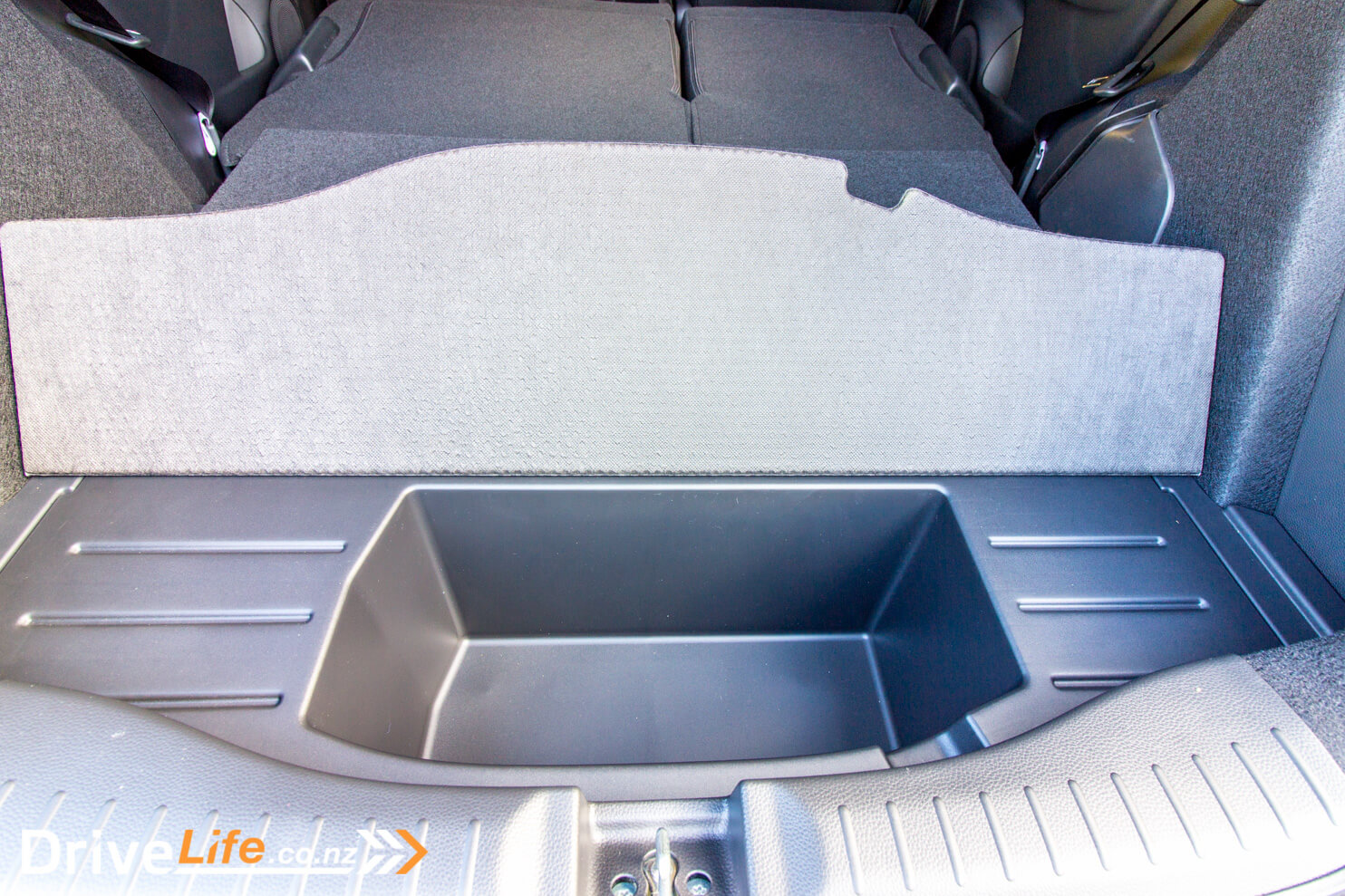
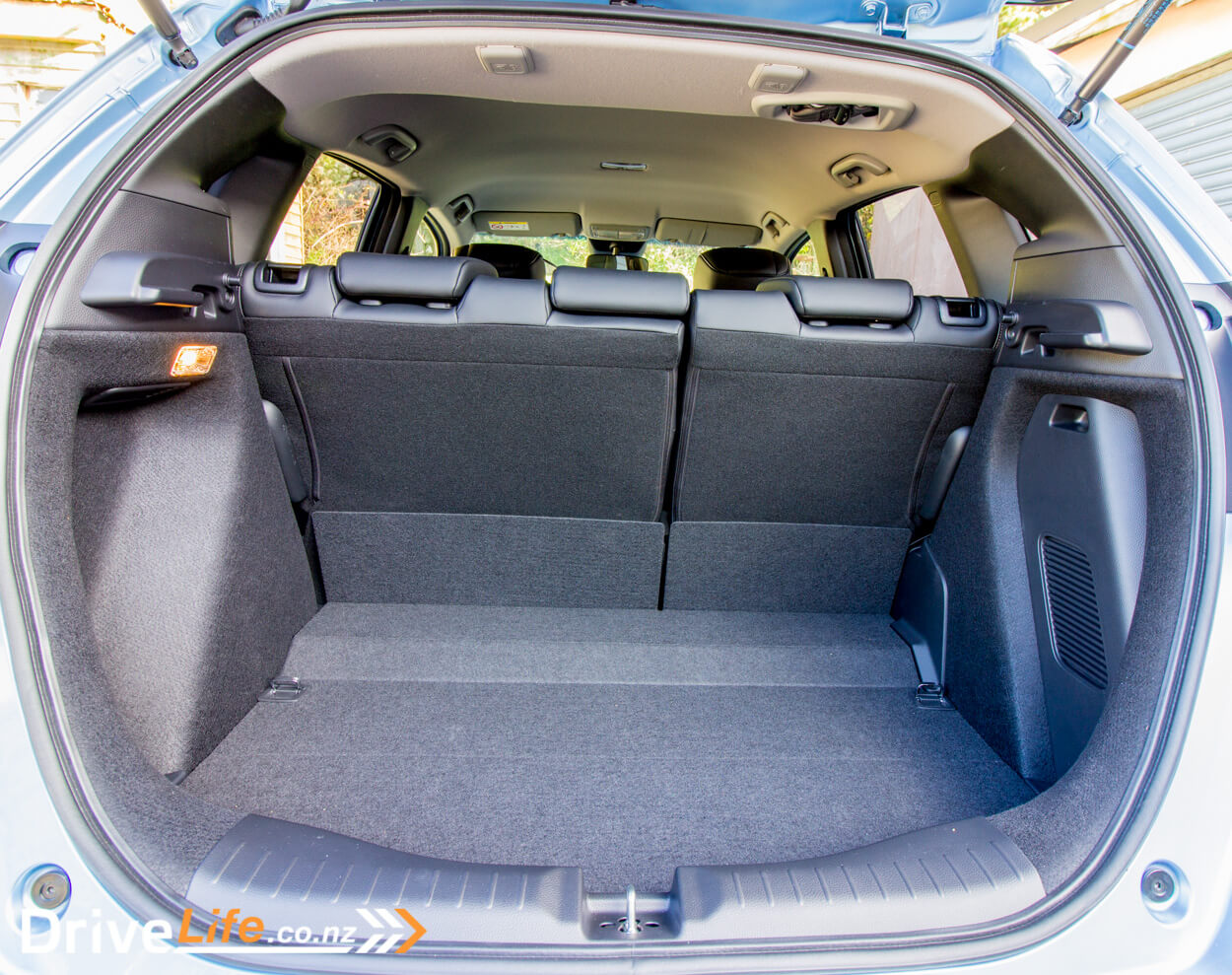
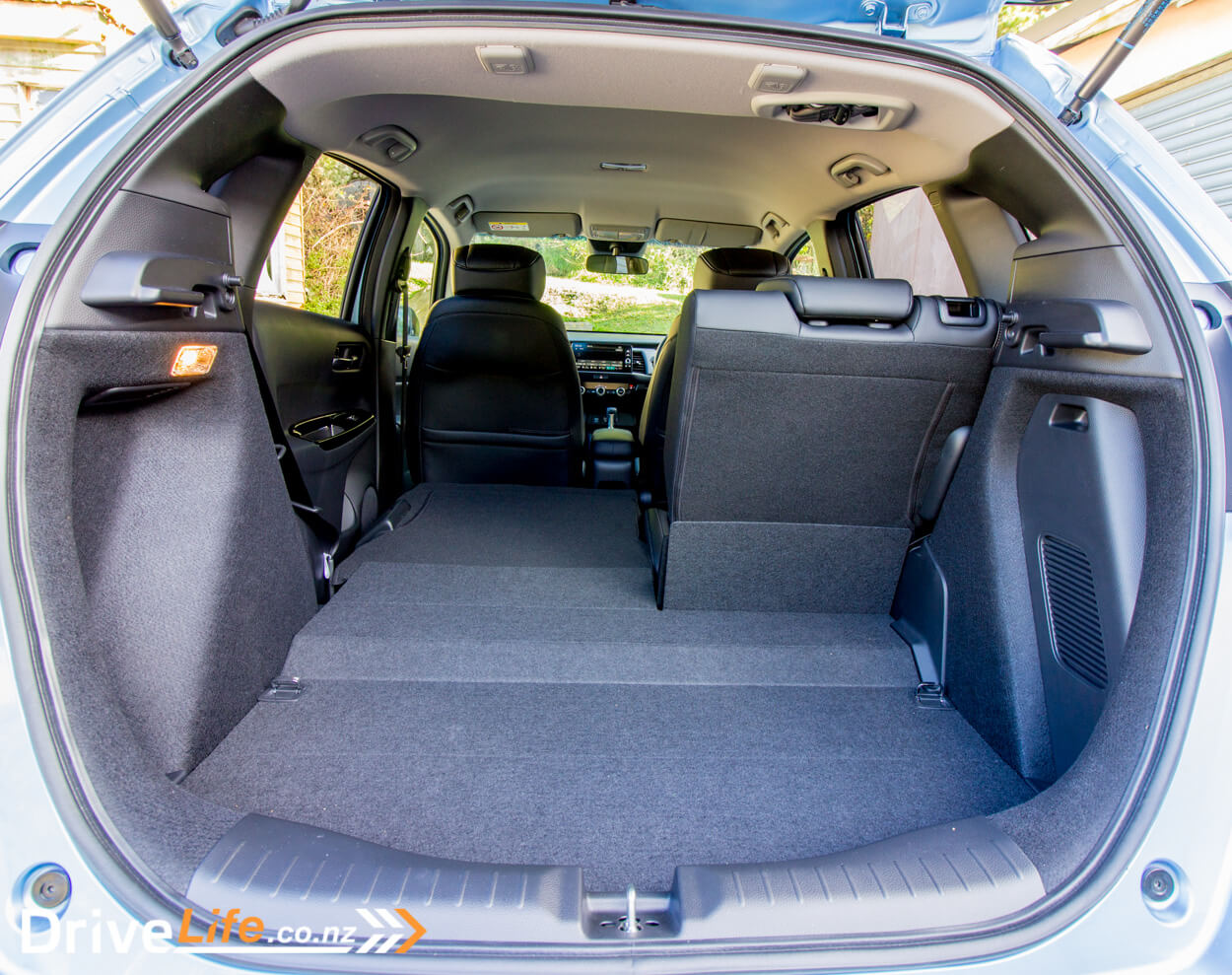
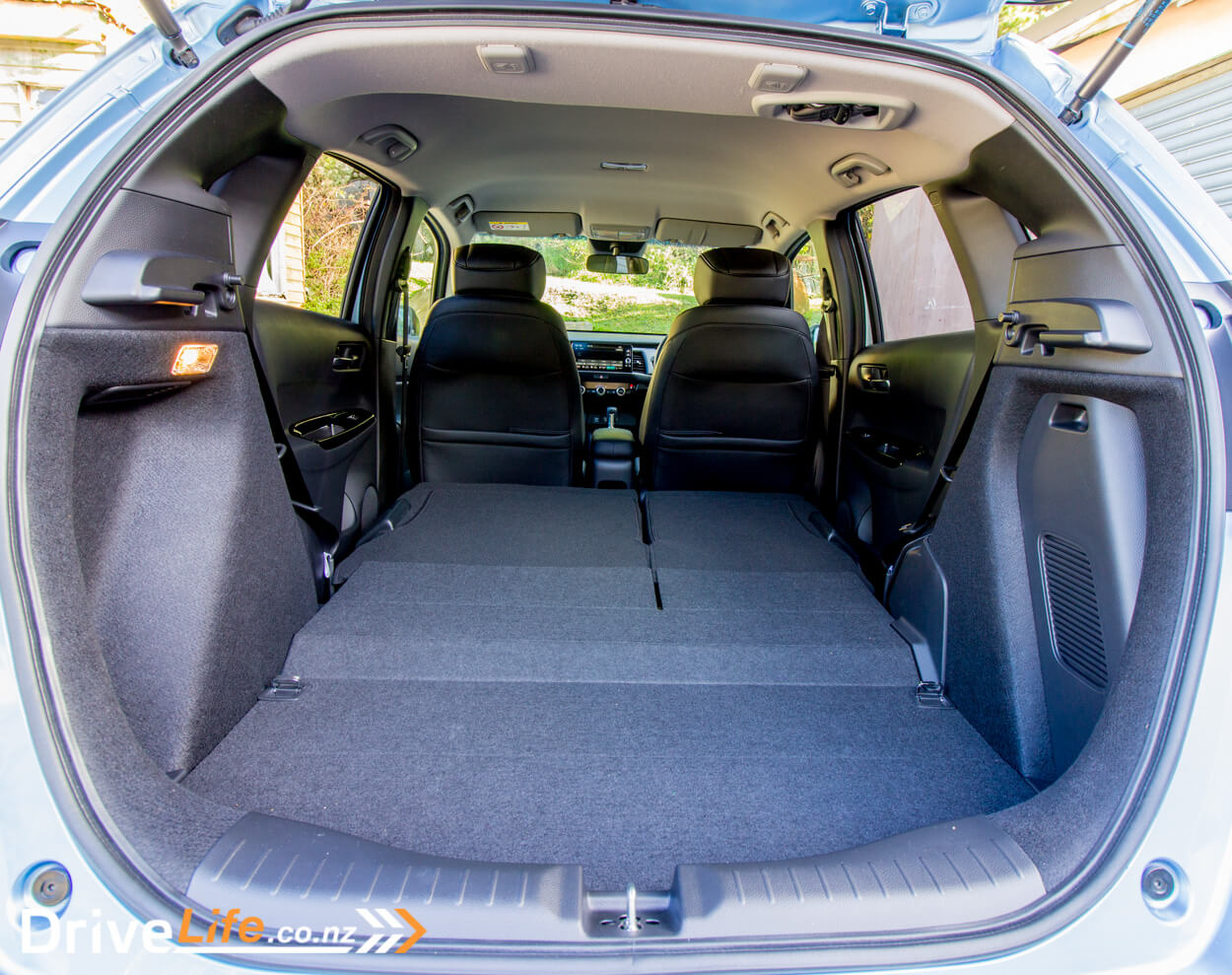
Don’t expect to find a spare tyre of any sort. The side of the boot has a can of tyre sealant in case of a flat, but along with a wheel brace at least. Tucked above all this is a 12-volt tyre pump, so all is not lost.
What’s A 2021 Honda Jazz e:HEV Luxe Like To Drive?
As mentioned, my two weeks with the Jazz Luxe included a drive to Taupo and back. While I had a different car organised for this trip, that fell through and so it was the micro-car Jazz for the trip for two of us. If I’m being honest, a weekend away in the Jazz and not a bigger car didn’t really appeal, but I needn’t have worried. The Jazz took the trip in its stride, and all it did was reinforce just what a great allrounder the car is.
With plenty of room, awesome visibility and the peppiness of the hybrid drivetrain, the Jazz Luxe did bloody well, and is a competent open-road performer. It’s no ball of fire, but the extra kick of the petrol engine when needed means that passing is not really an issue, and hills are taken easily, even with a reasonable amount of gear on board.

Wind noise on the open road or the motorway is low, and on the whole so is tyre noise. Coarse chip seal can make those Yokohama BluEarth tyres sing sometimes, but it’s never really bad. Road noise is well controlled too, and the car is a quiet and comfortable open road drive. Sitting at 100km/h is a pleasant and enjoyable experience.
Off the mark, the Jazz Luxe gets off the line quickly and will move away from other traffic easily. If there’s one negative thing in the driving of the Jazz e:HEV Luxe, it’s the engine noise up hills or under heavy load. It’s not as bad as the all-new 1.5-litre, 3-cylinder in the Toyota Yaris Hybrid, but it’s one thing that stops the Jazz’ drivability heading towards the ‘great’ zone.
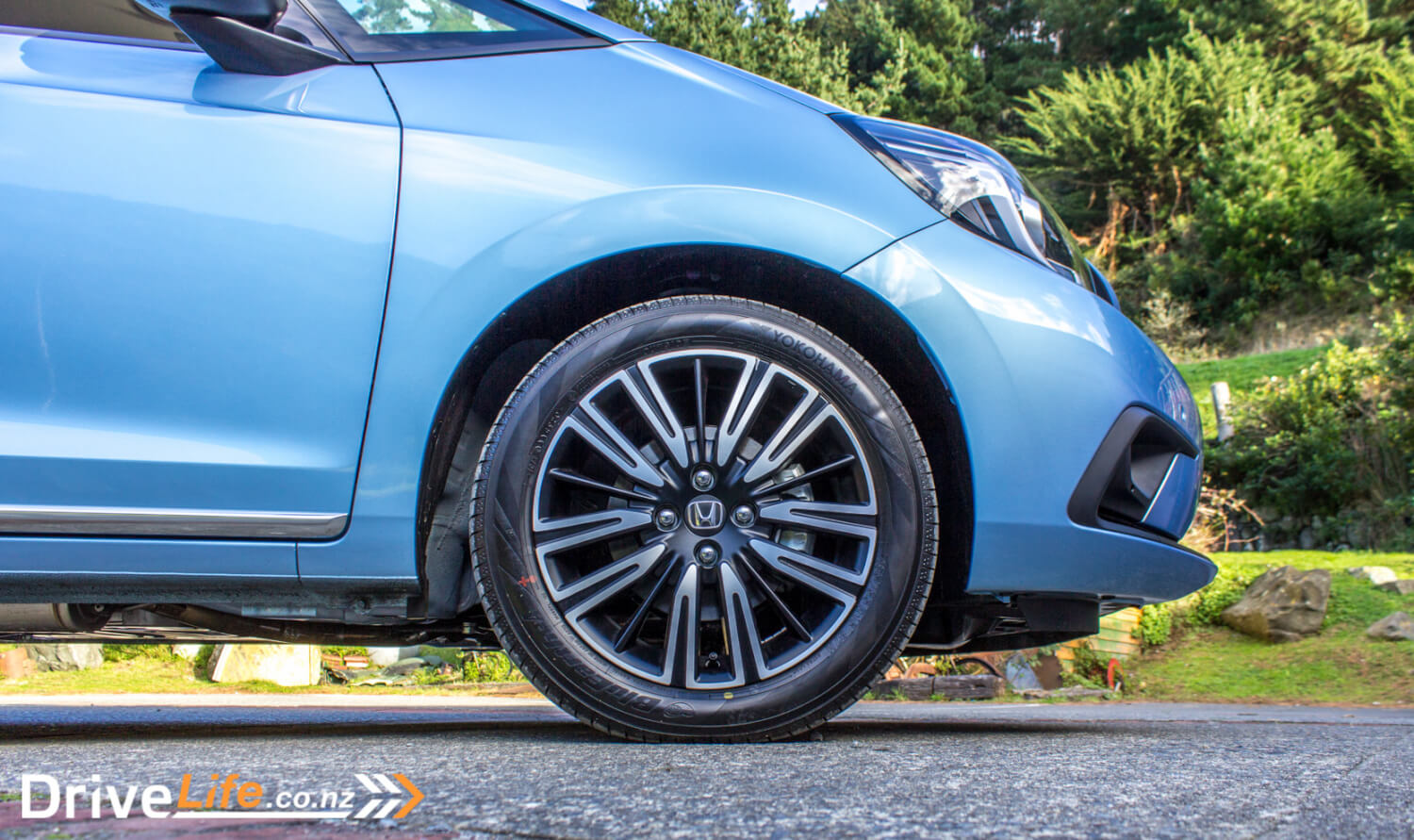
On a long trip, a hybrid doesn’t do its best work as far as fuel economy goes. On the 400Km drive to Taupo, the Jazz averaged 5.2L/100Km. The car does have an Eco mode button, but I didn’t use it on the way up. On the way to a meeting in Acacia Bay, I noticed the fuel gauge heading down into the ‘need more’ department. The car didn’t get delivered with a full tank, so the trip north used up much of what was available. After the meeting, we headed from Acacia Bay into Taupo to get some gas. On leaving the house, our fuel range was 1Km, and after 1Km? It was 0Km. So it was steady on the gas pedal, and trying to keep the car in EV mode wherever I could. There’s no ‘EV’ button, so you can just make the car run using its batteries. After 8Km we got into Taupo – the slight rise into the township the ‘do or die’ zone – and made it to a gas station. After filling the car, it took 39.8 litres so we still had 200mls of petrol to go. If the car wasn’t a hybrid, we wouldn’t have made it, I’m sure. Yes, I should have got fuel sooner, but we were already late so that wasn’t really an option.
The next day and we were heading back home to Wellington, this time running the car in Eco mode all the way. Like the Toyota Prius Prime when you turn on the AC in the Jazz hybrid, it will often start the engine, using up your valuable fuel, so I tried keeping the AC off as much as possible, and instead using the heated seats to keep warm. I can happily say that the heated seats in the Jazz remember the last setting when you get out of the car and then back in, something that lots of cars do not do.

After another 400Km and in Eco mode, fuel economy was 5.0L/100km, so a little bit better than not Eco. For me, it wasn’t enough to worry about, so I left Eco mode off for the rest of my time with the car. In saying that, Eco mode doesn’t dull performance too much, so if you were keen to, you could leave it in Eco 24/7. The car will stay in Eco even if you get out and back in again.
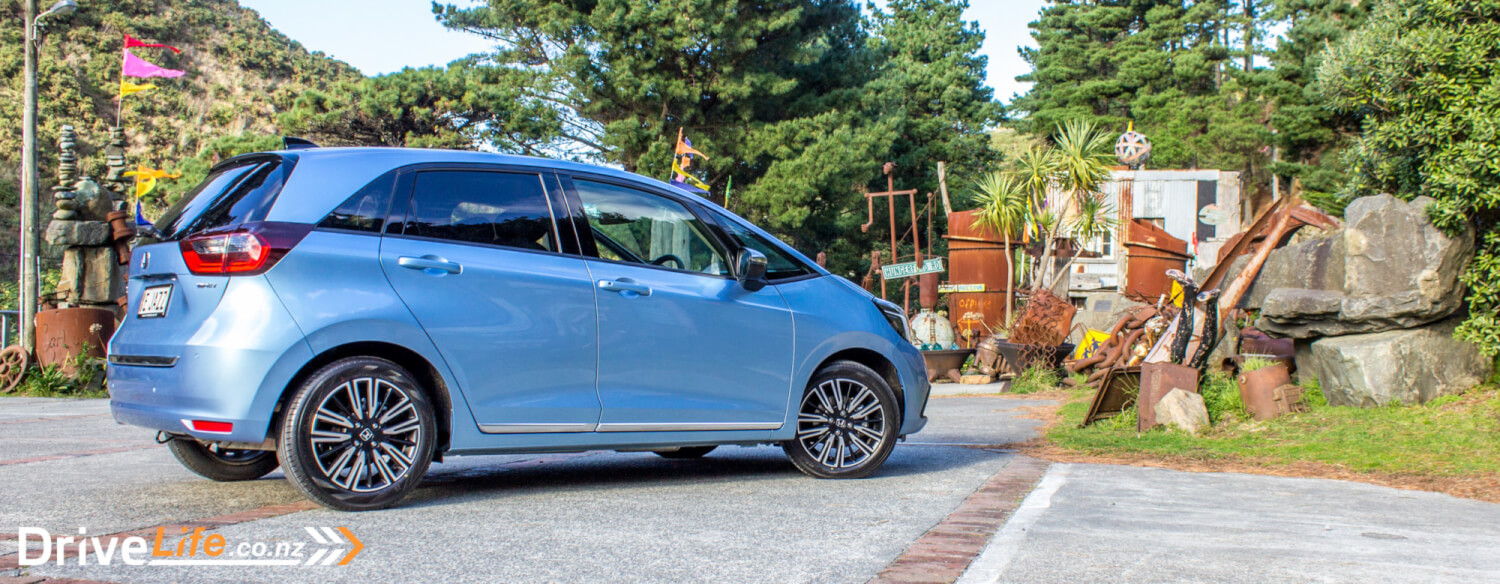
At the launch, I was amazed at the handling of this little car. It did well, with the wheels seeming to track nicely, dropping into the bends and smoothing out bumpy corners. On driving across the Desert Road this was simply reinforced; it does handle well, it tracks well and it rides extremely well. We’re seeing so many small/micro cars that have an excellent ride, with great advances happening in this area in just the last few years. Ride quality on the Jazz is right up with the rest in this segment.
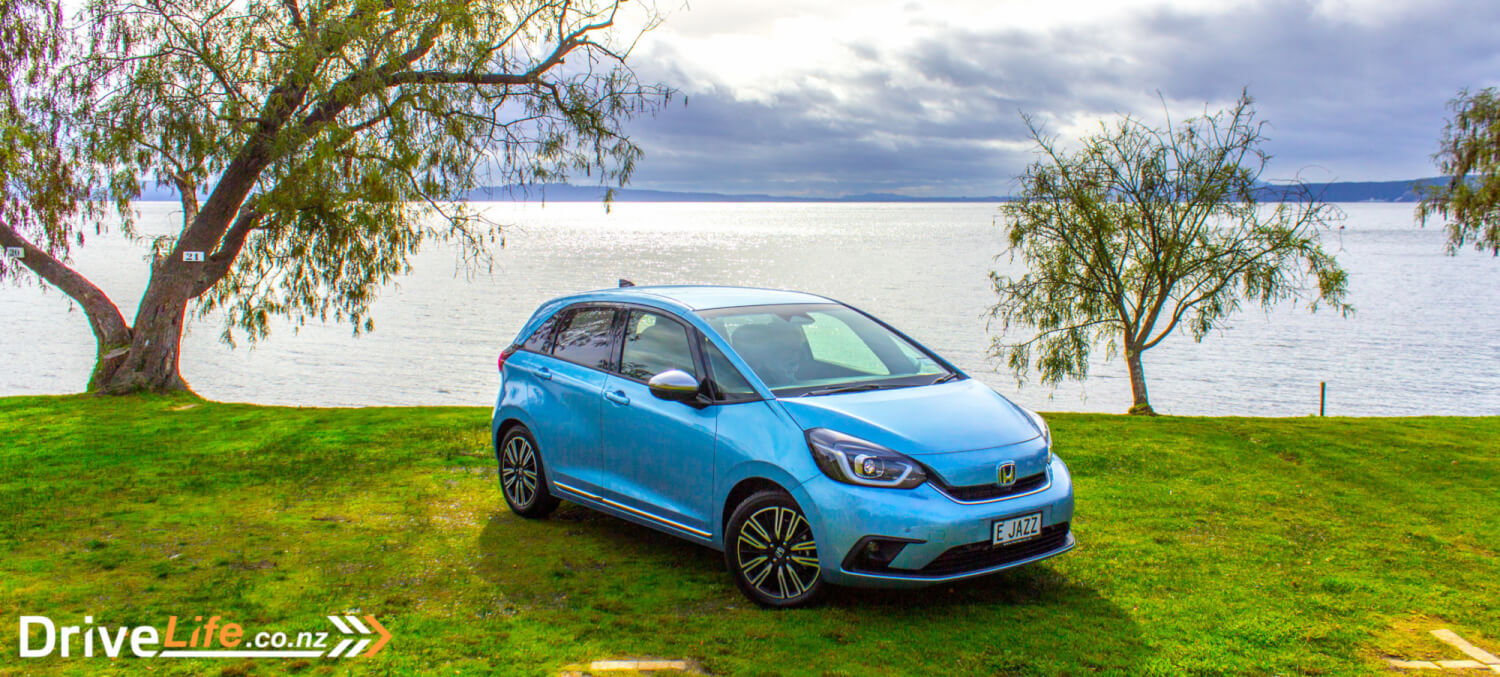
Also in the launch article, we covered off the hybrid system and how it works in the Jazz – it is a bit different to other hybrids. In a nutshell, there’s three modes; EV only, EV driving the car and engine charging the batteries, and lastly engine driving the front wheels. This does mean that even at 100km/h you may be running on battery power, until they get low enough to force the engine to start and drive the wheels, shown by a little cog in the driver’s information display.
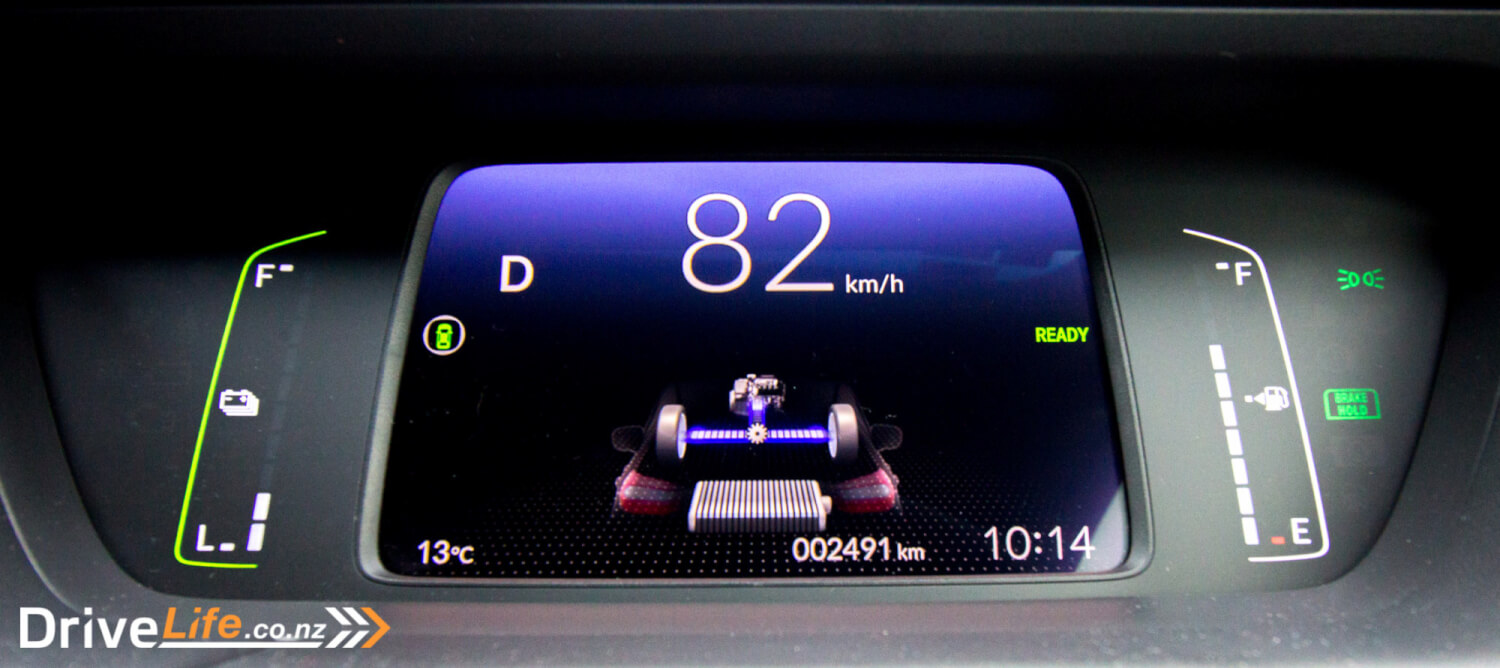
The whole system works brilliantly, and there’s almost no way of telling there’s anything changing, other than hearing the engine sometimes. It’s seamless and doesn’t need any diver input to make it work well, with a reasonably satisfying driving experience thrown in. In the past I’ve always felt I had to have an EV button to force the car to run on batteries only, but the Jazz Luxe proved to me it doesn’t really matter
Enough of the hybrid side of things – what’s it like on the daily commute? It’s pretty darn fine, with your view dominated by that massive windscreen and slim pillars. It’s so obvious Honda has done a lot of work on this front, and it has totally paid off. The view out the windscreen is mind blowing. This, along with good-sized side windows means that the Jazz is a good motorway commuter. It’s not perfect; even though this is the top-spec model, for some reason there’s no blind spot monitoring, which would make the car just that much better. Even more strangely, Honda have decided not to add their excellent Lane Watch camera system that’s fitted to many other Honda models.
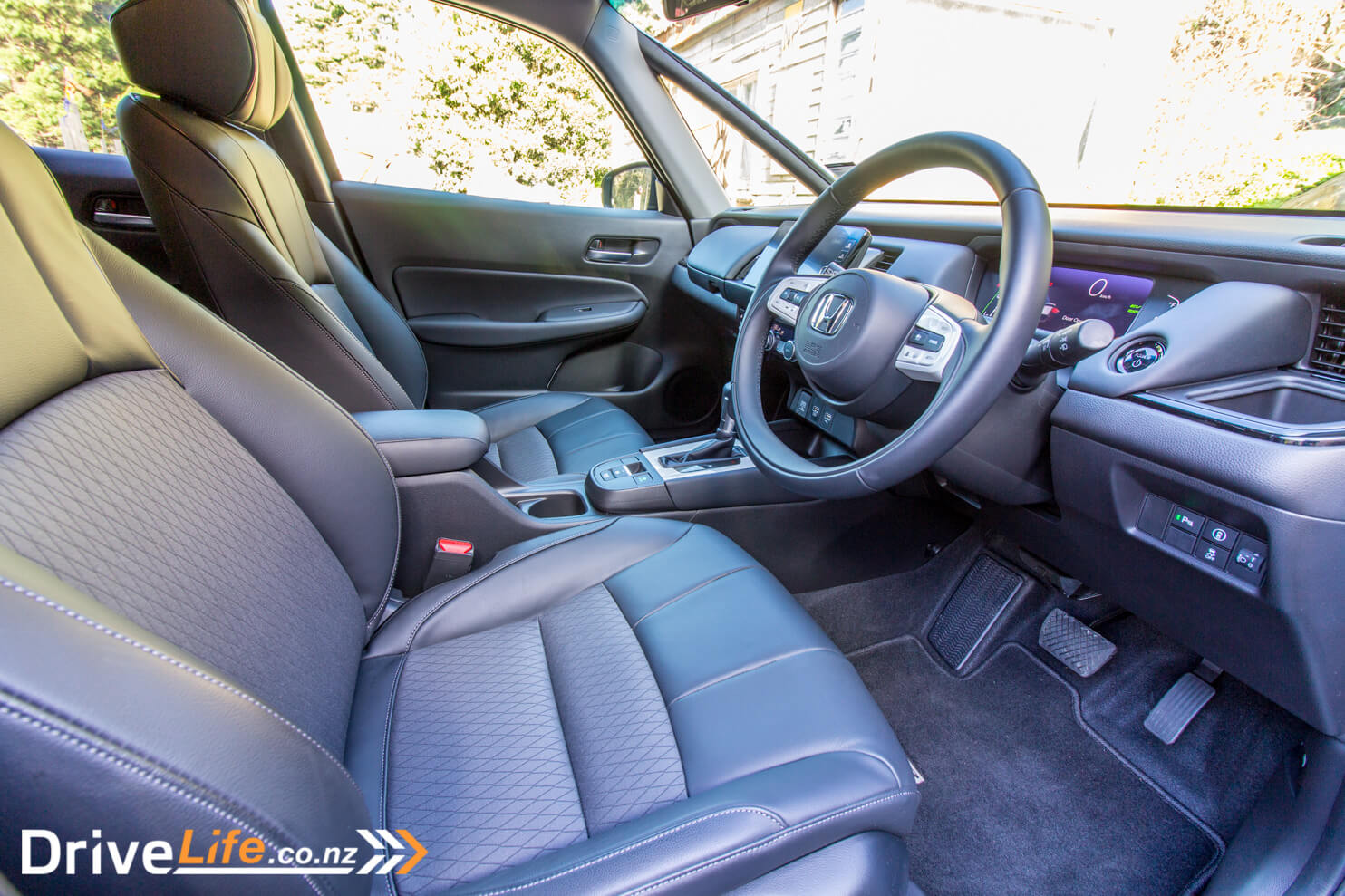
There are no automatic wipers, and if we are comparing to the Yaris ZR Hybrid, there’s no heads-up display either, something that the Yaris has and I love.
While this model has adaptive cruise control, it doesn’t bring the car to a stop, instead giving you a chime at about 25km/h as a warning to take over ‘driving’ the car. With so few new cars not being able to bring the car to a stop using adaptive cruise, this was surprising.
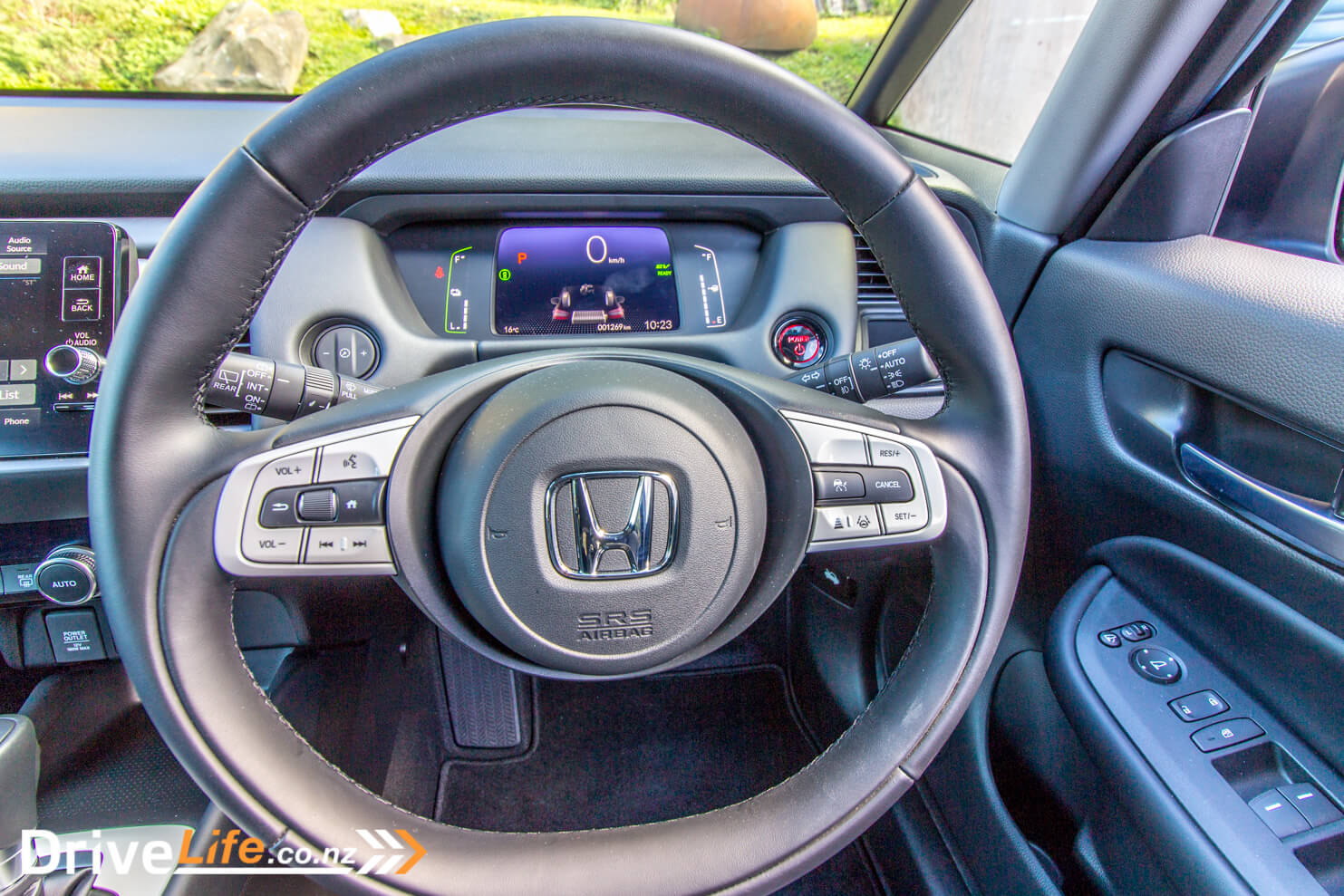
On that trip to Taupo, the seats felt too firm, and it was numb-bum after a couple of hours in the car. This just forced a coffee stop to get out, so that’s not a bad thing. The front seats have good side support, but the cushion is definitely on the firm side.
On the plus side of things, all the windows are automatic up/down, and at last we’re seeing wireless Apple CarPlay filter down to cars the size of the Jazz. It’s not wireless for Android Auto though (unlike the Kia Stonic we recently reviewed) but hopefully the next update will see this included.
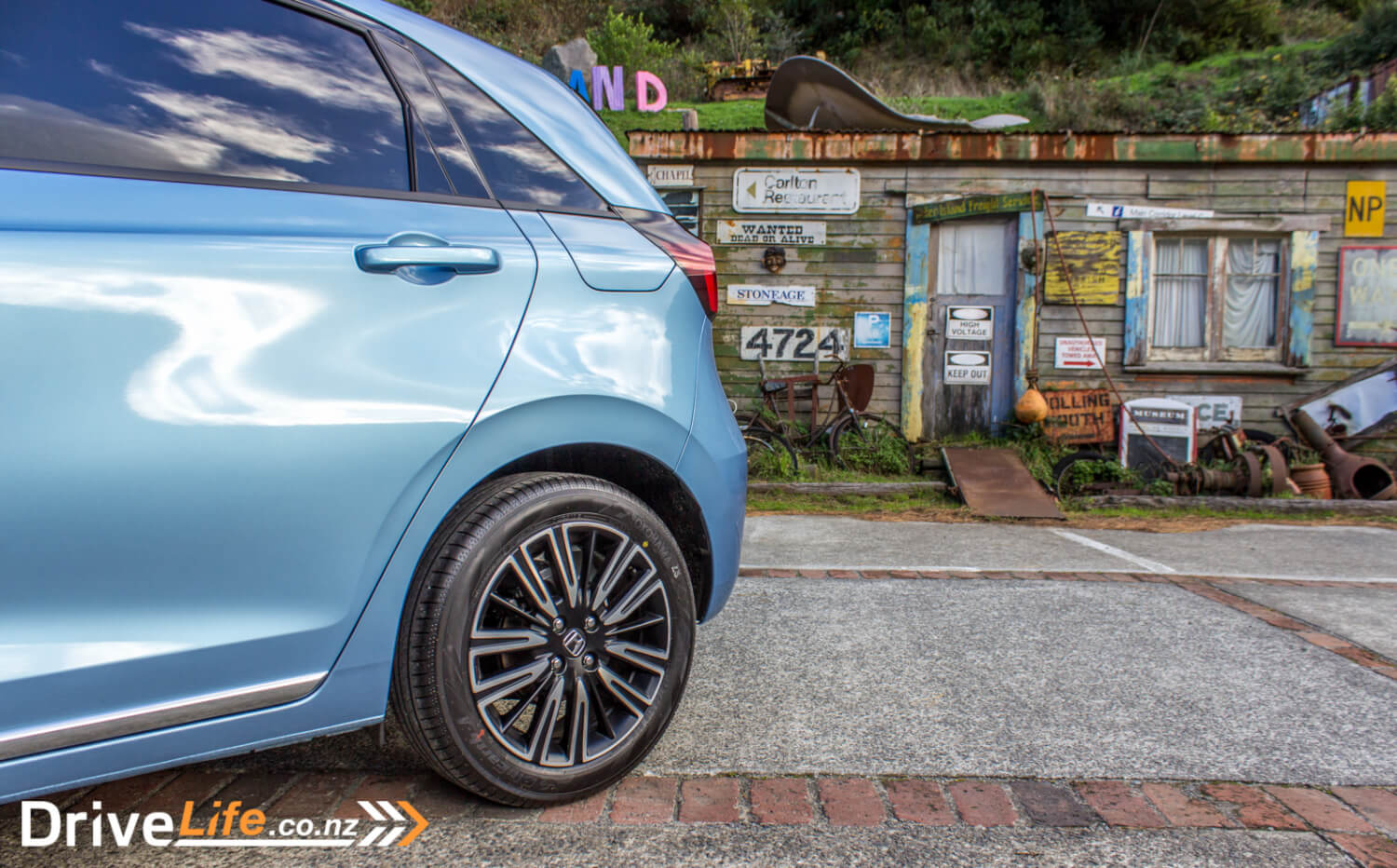
So, what about overall fuel economy? Since this is what the hybrid Jazz is all about, it’s what everyone wants to know. After driving those 2,400 km, overall the Jazz used 4.5L/100km. That’s not a great result, but from past experience we know that Wellington’s hills absolutely kill any EV’s range or hybrid’s fuel economy. I reset the second trip meter to zero on our return to Wellington, and over the following 1,300Km, it used 4.2L/100km. Better, but still a long way from the claimed 2.8.
Comparing this to the Yaris ZR Hybrid we had recently, that returned 4.0L/100Km while the Suzuki Swift Hybrid managed 5.4. So the Honda is well ahead of the Swift Hybrid, and just a little behind our real-world figures for the Yaris Hybrid.

What’s The Competition For The 2021 Honda Jazz e:HEV Luxe?
| Brand/Model | Engine | Power/Torque kW/Nm | Seats | Cargo capacity, litres | Fuel L/100km | Price |
| Kia Niro Hybrid Ex (base model) | 1.6-litre, 4-cylinder petrol/hybrid | 104/265 | 5 | 401 | 3.8 | $39,990 |
| Toyota CH-R Hybrid FWD | 1.8-litre, 4-cylinder petrol/hybrid | 72/142 | 5 | 318 | 3.8 | $37,990 |
| Honda Jazz e:HEV Luxe | 1.5-litre, 4-cylinder VTEC petrol/hybrid | 72/13180/253 | 5 | 304 | 2.8 | $35,000 |
| Toyota Yaris ZR Hybrid | 1.5-litre, 3-cylinder petrol/hybrid | 67/120 | 5 | 270 | 3.3 | $32,990 |
| Suzuki Swift Hybrid LTD | 1.2-litre, 4-cylinder petrol/hybrid | 61/107 | 5 | 265 | 4.1 | $28,500 |

What’s The Pros and Cons Of The 2021 Honda Jazz e:HEV Luxe?
| Pros Visibility Driveability Interior space Magic Seats Infotainment quality and operation Wireless Apple CarPlay Safe handling Ride quality Seamless hybrid switching | Cons Engine can be noisy at times Pricier than its competition Adaptive cruise not to a stop Missing some expected features |
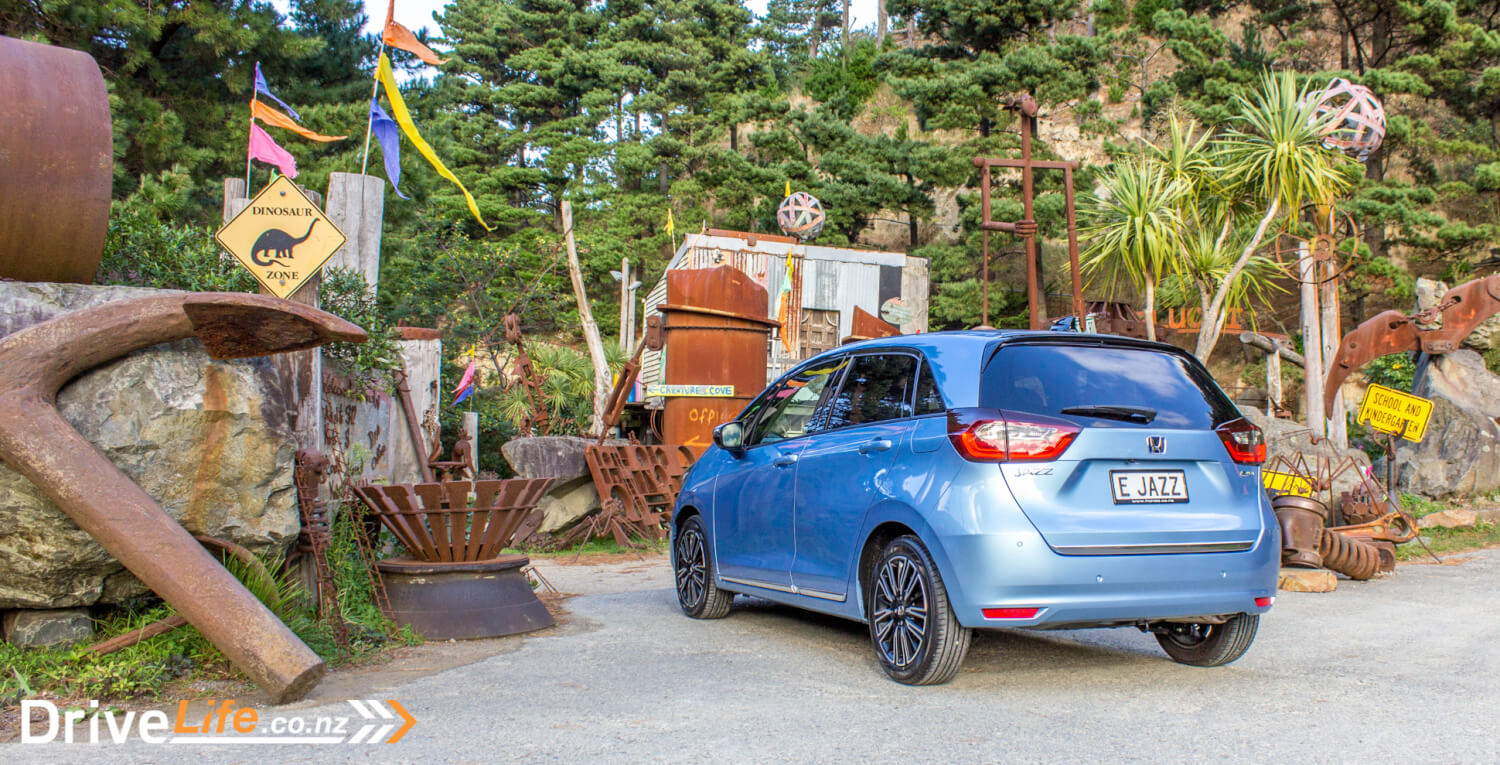
2021 Honda Jazz e:HEV Luxe – Specfications
| Vehicle Type | 5-door, micro hybrid-hatchback |
| Starting Price | $35,000 |
| Price as Tested | $35,000 |
| Engine | e:HEV 1.5L, Two Motor Hybrid, 4 Cylinder, 16 valve, i-VTEC, Chain Drive DOHC |
| Power, Torque kW/Nm | Petrol: 72@6,400rpm, 131@4,500rpm Electric: 80/253 |
| Transmission | e-CVT Electronic Control Continuously Variable Fixed Gear Transmission |
| Spare Wheel | Pump only |
| Kerb Weight, Kg | 1,590 |
| Length x Width x Height, mm | 4035x1695x1537 |
| Cargo Capacity, litres Seats up/seats down | 304/1205 |
| Fuel capacity, litres | 40 |
| Fuel Efficiency L/100Km | Advertised Spec – combined – 2.8 Real World Test – combined – 4.5 Low Usage: 0-6 / Medium Usage 6-12 / High Usage 12+ |
| Towing Capacity Kg, unbraked/braked | Not rated |
| Turning circle, metres | 11.0 Small: 6-10m / Medium 10-12m / Large 12m+ |
| Warranty | 5 Years, unlimited KM 5 Years, Roadside Assist 5 years, 100,000km hybrid battery warranty |
| ANCAP Safety Ratings | Not yet rated |


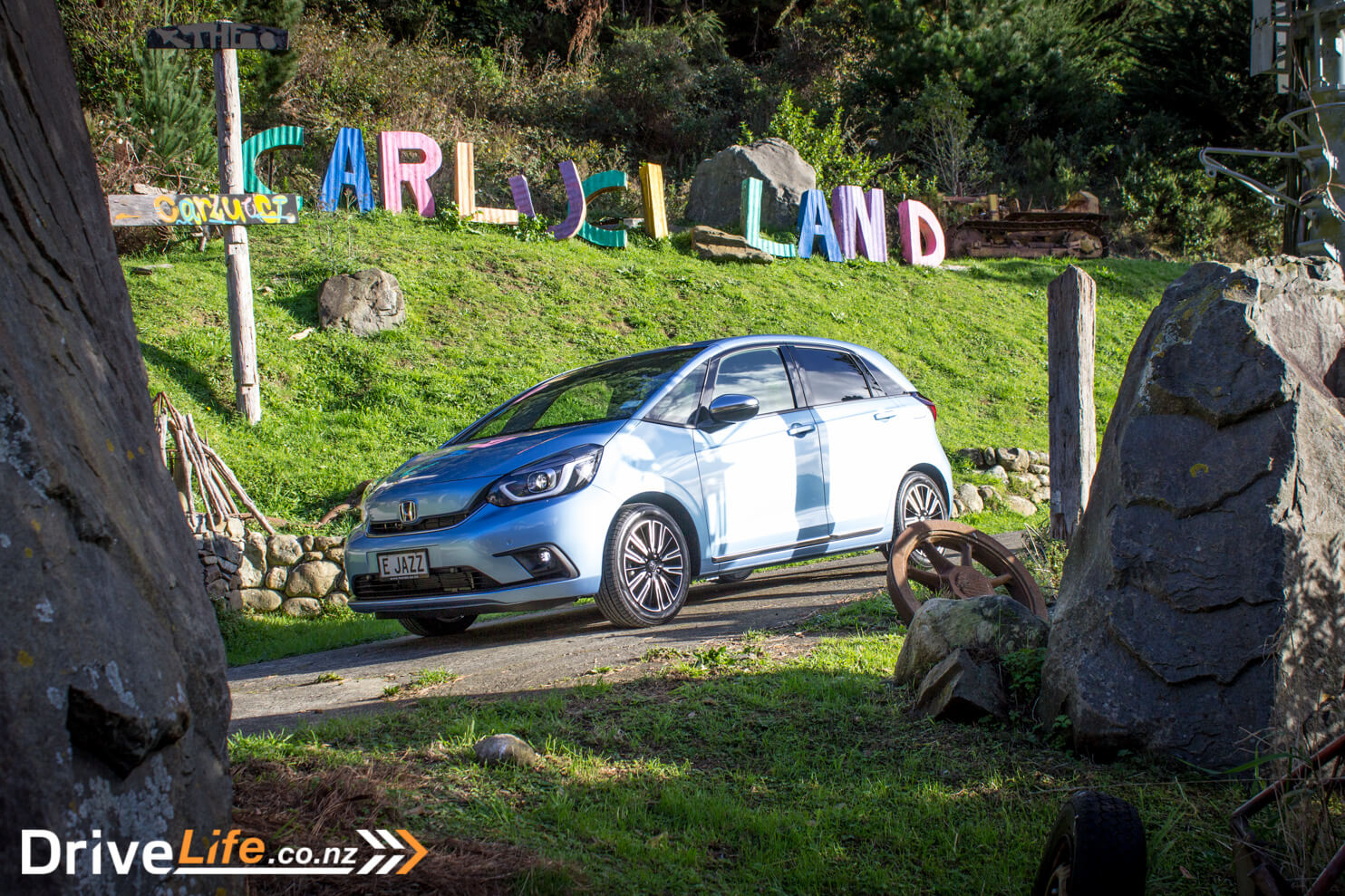











































Nice work.
I drive an earlier model Jazz at the moment and currently pleased with it even at 166 k on the clock.
Must admit looking at the pictures of the dashboard can’t help thinking He Honda has borrowed the French design of the Renault 5 specifically the late 70’s 80’s models.
Hi John
I drove a 12-year-old Jazz manual 1.3 from Auckland to Wellington with four adults and loads of luggage on board, and it did bloody well. Impressive with all the weight on board, and still loads of room.
With Magic Seats, it’s hard to go past as a micro.
Cheers
Fred
I bought the new Jazz e:HEV Luxe and loving it, I agree with most of what you wrote it is an extremely good quality car and the interior is way nicer than Yaris, it feels European.
You forgot to mention that the Metroid grey colour comes in brown leather tone seat and dashboard and door trim which looks cool 🙂
Sad it does not have rear cross traffic alert and blind spot monitoring could have been perfect, I think I would prefer the Crosstar if it already have the e:HEV like they do in Europe!
HI Kelvin, thanks for the comment.
Yes, I did forget about the brown interior – I saw it at the launch and loved it as well. Hopefully, our next test Jazz will come with this interior. Congratulations on the purchase – it’s truly an excellent car.
Once the HEV Crosstar arrives, the Yaris Cross hybrid will have some stiff competition if Honda can do some magic with the pricing.
Hi Fred
Many thanks for a superb down to earth review of the Jazz Luxe.
I have driven a luxe for about 15 minutes and although I only had a taste I would have to say “I want one”. Like you I would like to see the Blind Spot monitoring and Lane Watch Camera.
However in the short time I drove the car (which was all on 50 or 60k roads) the thing that caught my attention was that every time I braked (soft or otherwise) I would see the front of the car dip. Actually what I was seeing was the base of the large windscreen dip. I have never noticed this on other cars before except under hard braking. Maybe its because the base of the windscreen is straight and so wide and that you only see a small part of the bonnet. Initially I saw the dip in my peripheral so then I started watching for it and then it became annoying. If I buy a Luxe hopefully I will get use to it or ignore it.
Did you notice this at all? Cheers Gary
Hi Gary. No, didn’t notice any dipping down at the front at all. Weird. It is such an enormous windscreen, but I wouldn’t think that would factor into it.
Cheers
Fred